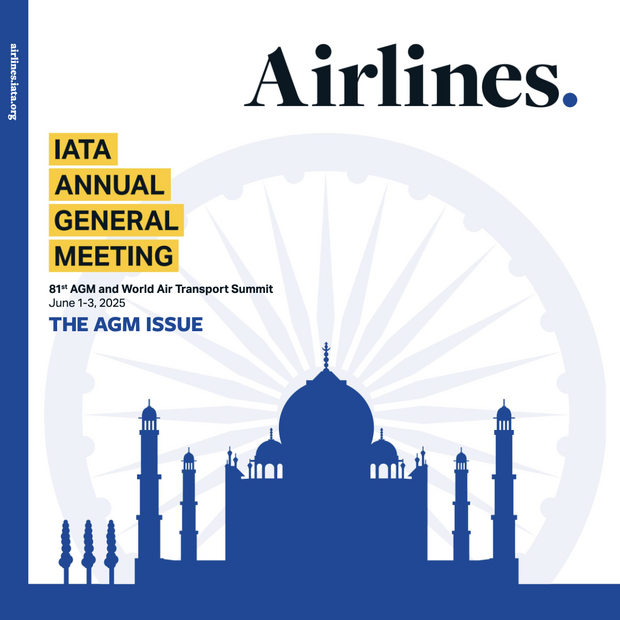
Translations:
(pdf) الطلب على السفر الجوي يرتفع بنسبة 3.3% في شهر مارس
国际航协:3月客运需求增长3.3% (pdf)
La demanda de pasajeros aéreos crece 3,3% en marzo (pdf)
Demanda de passageiros aéreos aumenta 3,3% em março (pdf)
Le trafic de passagers en hausse de 3,3 % en mars (pdf)
Geneva - The International Air Transport Association (IATA) released data for March 2025 global passenger demand for air travel with the following highlights:
- Total demand, measured in revenue passenger kilometers (RPK), was up 3.3% compared to March 2024. Total capacity, measured in available seat kilometers (ASK), was up 5.3% year-on-year. The March load factor was 80.7% (-1.6 ppt compared to March 2024).
- International demand rose 4.9% compared to March 2024. Capacity was up 7.0% year-on-year, and the load factor was 79.9% (-1.7 ppt compared to March 2024).
- Domestic demand increased 0.9% compared to March 2024. Capacity was up 2.5% year-on-year. The load factor was 82.0% (-1.3 ppt compared to March 2024).
“Passenger demand grew by 3.3% year-on-year in March, a slight strengthening from the 2.7% growth reported for February. A capacity expansion of 5.3%, however, outpaced the demand expansion leading to a load factor decline from record highs to 80.7% systemwide. There remains a lot of speculation around the potential impacts of tariffs and other economic headwinds on travel. While the small decline in demand in North America needs to be watched carefully, March numbers continued to show a global pattern of growth for air travel. That means the challenges associated with accommodating more people who need to travel—specifically alleviating supply chain problems and ensuring sufficient airport and air traffic management capacity—remain urgent,” said Willie Walsh, IATA’s Director General.
Air Passenger Market in Detail
| March 2025 (% year-on-year) | World Share1 | RPK | ASK | PLF(%-PT)2 | PLF(Level)3 |
|---|---|---|---|---|---|
| Total Market | 100% | 3.3% | 5.3% | -1.6% | 80.7% |
| Africa | 2.2% | 4.1% | 5.0% | -0.6% | 71.5% |
| Asia Pacific | 33.5% | 6.3% | 5.9% | +0.3% | 83.5% |
| Europe | 26.7% | 4.4% | 6.4% | -1.5% | 79.2% |
| Latin America | 5.3% | 6.2% | 8.8% | -2.0% | 80.8% |
| Middle East | 9.4% | -0.7% | 3.0% | -2.8% | 74.7% |
| North America | 22.9% | -1.1% | 3.5% | -3.8% | 81.4% |
1) % of industry RPKs in 2024 2) Year-on-year change in load factor 3) Load Factor Level
Regional Breakdown - International Passenger Markets
International RPK growth slowed to 4.9% in March year-on-year from the 5.9% reported for February and from the 12.5% reported in January. This slowdown since January reflects in large part the final normalization of year-on-year demand comparisons post-COVID. Asia-Pacific was the strongest performer among regions with 9.9% growth. Load factors fell in every region, for a -1.7 ppt overall decline.
Asia-Pacific airlines reported a 9.9% year-on-year increase in demand. Capacity increased 11.6% year-on-year, and the load factor was 84.1% (-1.3 ppt compared to March 2024).
European carriers had a 4.9% year-on-year increase in demand. Capacity increased 6.9% year-on-year, and the load factor was 78.2% (-1.5 ppt compared to March 2024).
Middle Eastern carriers saw a -1.0% year-on-year decline in demand. Capacity increased 2.8% year-on-year, and the load factor was 74.6% (-2.9 ppt compared to March 2024). The decline in demand is likely related to the timing of Ramadan which impacts travel patterns.
North American carriers saw a -0.1% year-on-year fall in demand. Capacity increased 2.0% year-on-year, and the load factor was 83.0% (-1.8 ppt compared to March 2024). While demand had a second consecutive month of year-on-year contraction, it is important to note that this is an improvement on the -1.5% decline reported for February.
Latin American airlines saw a 7.7% year-on-year increase in demand. Capacity climbed 12.1% year-on-year. The load factor was 80.9% (-3.3 ppt compared to March 2024).
African airlines saw a 3.3% year-on-year increase in demand. Capacity was up 3.5% year-on-year. The load factor was 70.1% (-0.2 ppt compared to March 2024).
Domestic Passenger Markets
Domestic air travel posted a marginal 0.9% gain, weighed down by declines in the US and Australian markets. Brazil and India reported the strongest growth at 8.9% and 11.0% respectively. Meanwhile, Australia (-1.2%) and the US (-1.7%) reported declines. The load factor fell -1.3 ppt as domestic capacity expanded 2.5%.
| March 2025 (% year-on-year) | World Share1 | RPK | ASK | PLF(%-PT)2 | PLF(LEVEL)3 |
|---|---|---|---|---|---|
| Domestic | 38.2% | 0.9% | 2.5% | -1.3% | 82.0% |
| Domestic Australia | 0.8% | -1.2% | -4.1% | +2.4% | 81.8% |
| Domestic Brazil | 1.1% | 8.9% | 8.3% | +0.4% | 80.4% |
| Domestic China P.R. | 11.3% | 1.7% | -0.8% | +2.1% | 83.2% |
| Domestic India | 1.6% | 11.0% | 14.5% | -2.6% | 83.3% |
| Domestic Japan | 1.0% | 8.0% | 2.7% | +4.2% | 84.4% |
| Domestic US | 14.4% | -1.7% | 4.2% | -4.8% | 80.3% |
1) % of industry RPKs in 2024 2) year-on-year change in load factor 3) Load Factor Level
Note: the six domestic passenger markets for which broken-down data are available account for approximately 30.2% of global total RPKs and 79.1% of total domestic RPKs.
> View the March 2025 Air Passenger Market Analysis (pdf)
For more information, please contact:
Corporate Communications
Tel: +41 22 770 2967
Email: corpcomms@iata.org
Notes for Editors:
- IATA (International Air Transport Association) represents some 360 airlines comprising over 80% of global air traffic.
- You can follow us on X for announcements, policy positions, and other useful industry information.
- Fly Net Zero
- Statistics compiled by IATA Economics using direct airline reporting complemented by estimates, including the use of FlightRadar24 data provided under license.
- All figures are provisional and represent total reporting at time of publication plus estimates for missing data. Historic figures are subject to revision.
- Domestic RPKs accounted for about 38.2% of the total market in 2024. The six domestic markets in this report account for 30.2% of global RPKs.
- Explanation of measurement terms:
- RPK: Revenue Passenger Kilometers measures actual passenger traffic
- ASK: Available Seat Kilometers measures available passenger capacity
- PLF: Passenger Load Factor is % of ASKs used.
- IATA statistics cover international and domestic scheduled air traffic for IATA member and non-member airlines.
- Total passenger traffic market shares by region of carriers for 2024 in terms of RPK are: Asia-Pacific 33.5%, Europe 26.7%, North America 22.9%, Middle East 9.4%, Latin America 5.3%, and Africa 2.2%.

